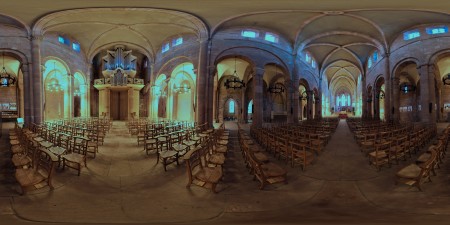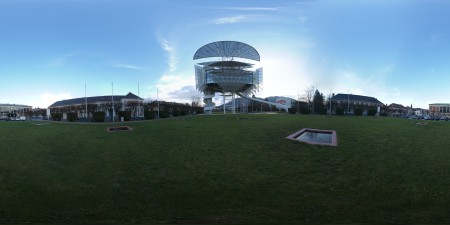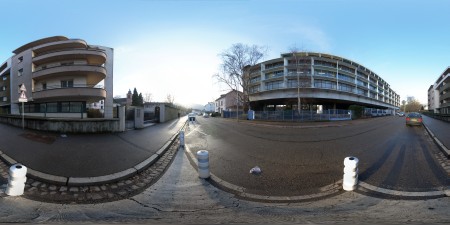Click on the photograph or the link below to go to the page containing the panoramas
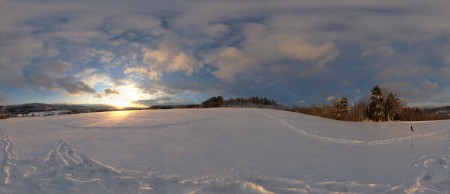
Category Archives: News – 2009/10
Snowy Candlemas: Everyday life in Entre-deux-Eaux, Year 8 weeks 29 – 40
To download a printable Adobe Acrobat version click on this link E2EYear8Weeks29-40.pdf (three A4 pages)
If you’re still recovering from Christmas indulgence and are dieting strictly, this is not the newsletter for you, as food is the main subject.
All this time we’ve lived here we’ve not realised that we have an extra chance to eat pancakes today, February 2nd, as well as on Shrove Tuesday, if we keep both French and English traditions. We trudged through the snow yesterday to our next door neighbours, and they suddenly mentioned Chandeleur, pancakes and gold coins. France is such a secular society that they weren’t too sure of the origin of the tradition, but knew you had to toss your pancake with one hand whilst holding a gold coin in the other to ensure prosperity for the whole year. Cedric’s grandfather kept an old gold Napoleon for the occasion. In the old days, at Candlemas here people would bring back lighted candles from church to chase away evil and assure good crops for the year. And then when England’s eating pancakes before Lent starts, France eats beignets made from fried yeasted dough (doughnuts without a hole).
Talking of forgotten origins, our Scrabble group were discussing the galette des rois, a large pastry pie usually sold with a frangipane or apple puree filling. Nowadays it seems to be eaten throughout January at festive gatherings, and they were surprised that the English had nothing comparable (that I could think of!) The controversy arose over the kings in the name, with one of the group shouting loudly that it had nothing whatsoever to do with religion, and ignoring the others who pointed out that it used always to be eaten at Epiphany to celebrate the arrival of the three kings. As we are very fond of anything marzipan flavoured, John has willingly followed the trend of extending its date of consumption and has made at least 3 galettes des rois so far (with considerably more filling than the shop ones). However he didn’t put in the fève, originally a bean, now usually a collectible ceramic figurine, or wear the golden crown that’s given to the finder of the fève.
Of course, we’d also had a good dose of marzipan over Christmas, on our Christmas cake. It was sad that the whole family couldn’t be with us over Christmas, as originally planned. Ryanair is still a dirty word in the family, after they cancelled their Basel flights so close to Christmas. And then BA gave us some anxious moments with their threatened strike. In the end, the snow seemed the worst enemy, with Eurostar trains stuck in the Channel Tunnel and some British Airports closing down for periods. But Heathrow stayed open and Toby, Leila and Stella all arrived safely on December 20th, and the next day we celebrated Leila’s 30th birthday in style at the Frankenbourg restaurant. John had been worried about whether Christmas turkeys and capons needed to be ordered in advance and where best to purchase a tasty big ham. However, our local supermarket, Cora, did us proud and we had a roast ham on Christmas Eve, a capon on Christmas day and plenty of leftovers for Boxing Day. We toasted absent family, and thought of John’s sister’s family grounded in Billericay. On the 27th, their last full day here, the sun came out and there was fresh snow on the hills – ideal for a day’s skiing in Gérardmer for Toby and Stella. (It was so long since we’d been up to the ski slopes, that we even took the wrong turning and meandered up towards some remote hamlet).
It seems as if no newsletter is complete without a mention of sewage. So here goes, – hopefully the last mention for a while. The day after everyone left, the APE man rang and offered to come round shortly. (The APE man deals with Assainissement, Pompage and Entretien and we’d rather given up on his assurance that he would come sometime to empty our septic tanks). He arrived in the rain wearing a cowboy hat and tight jeans, and while we were showing his overalled young helpers the septic tanks, he rashly drove his tanker onto our field, where the wheels sank into the mud from the thawed snow and spun round ineffectually. No amount of revving, rocking, swearing, tiles and branches under the wheels would shift it. The ruts just got deeper. Hat still on and mobile clamped to his ear, the APE man descended and stomped off wordlessly down the road. His assistants shrugged helplessly as he’d not spoken to them. He returned having been unable to rouse any tractor-owning neighbours. Then, after more digging in front of the wheels, filling those holes with more broken tiles and tree branches, the lorry did one final lurch and roll and somehow made it out! He parked on firm ground by the front door of the farmhouse, sucked up the sludge out of our main tank and the now-disconnected old tank, hosed down and rushed off, presumably to make a bit more money before further snow would make January a bad month for outdoor work. At least we’re legal now.
2010 was launched at midnight with a phone call from Toby to announce his engagement to Stella. The fireworks immediately went off in the villages all around. After all that excitement, things went quiet here for a week or two until I went, for the first time, to the annual meal offered by the Mayor and Council to all the village over 65s. (John wishes to point out that he doesn’t qualify yet).
I knew enough about the importance of food to arrive promptly at 12. After the mayor’s opening comments (including mention of those who are now in care homes and unable to come so he’d visited), everyone settled down at the long tables to chat as a potent fruit punch was brought round, followed by nibbles (squares of white bread, with fish and pate and salami toppings). More punch followed and conversation became animated. Then the white wine was served, to accompany a plateful of fishy starters – a big fish pie, prawns in mayonnaise, salad and a large prawn-like creature in full armour draped across the top (no one was sure quite what it was or how best to eat it!). It must have been during this course that the musical “animation” arrived. The man started with some amusing anecdotes (though I always missed the punchline!) and followed with tunes from yesteryear. Then there was a between-courses delicious lime sorbet, served either with or without a very generous slosh of vodka. By this time I was slowing down a bit on the alcohol. Around 3 o’clock the red wine replaced the white in honour of the main course, a huge slice of Beef Wellington, with a separate individual bowl of potatoes in a cream sauce. It was just as well that John wasn’t there to stir up old prejudices with mock-innocent comments about Wellington’s inclusion at a French feast. Then the song books were produced. A nice touch was that the singer took her microphone round the tables and featured the voices of some of the elders. There was then a special stand-up sit-sown song to welcome the cheese board (and a round of wine), and everyone tucked in again. Then there was dancing – my goodness, they are nimble on their feet, some of them! Fruit salad brought the dancers back to the table. And at some point the accordionist and singer started to assemble long alpine horns and played them beautifully. Then just as I was thinking it was all over, the coffee, chocolates and liqueurs arrived and there was more dancing. And there was still a lot of dancing as the first people (including M. Laine who’d only come for the food, and wasn’t bothered about the company) started to leave. The roads must have been rather dangerous as the last revellers tottered home around 7 p.m.
As if the aged of Entre-deux-Eaux hadn’t had enough excitement, four days later the Assemblé Générale of their monthly club took place at 10.30. Most AGMs here seem to culminate in a large meal, to encourage attendance and payment of subs. The business lasted only 10 minutes, as the committee was already in place, and the outings had all been arranged. After an aperitif, the hearty eating (and drinking) started – with pastry in every course. The main course was a local speciality baeckeoffe – everyone had a large casserole of lamb, beef, pork, potato, leek, carrot, wine and juniper berry stew, sealed with pastry. Fruit tart followed. Around 3 the usual club activities took over, with cards, Scrabble and gossip. Then, fearing lest anyone was still hungry, around 5 the champagne glasses came out and galette des rois was produced and we all toasted each other. I arrived home about 8 hours after I set out for the AGM, to find John on the phone to Dorinda who was proposing trying out a restaurant in Alsace the following lunch time!
La Table de Mittelwihr, which Dorinda had chosen, lies on the wine route, near Riquewihr, and was surprisingly busy for a January weekday, with a good menu of the day.
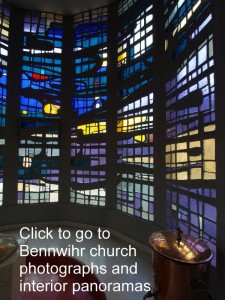
However the highlight of the day was stopping to see a modern church in the next village of Bennwihr, which we’d always just driven past. The old church had been destroyed towards the end of the war, as the Germans clung on tenaciously in Colmar area. The new church was very light and airy with its white pews and pale floor, with seven huge dramatic stained glass windows on the south side and more attractive glass in the side chapel and baptistry.
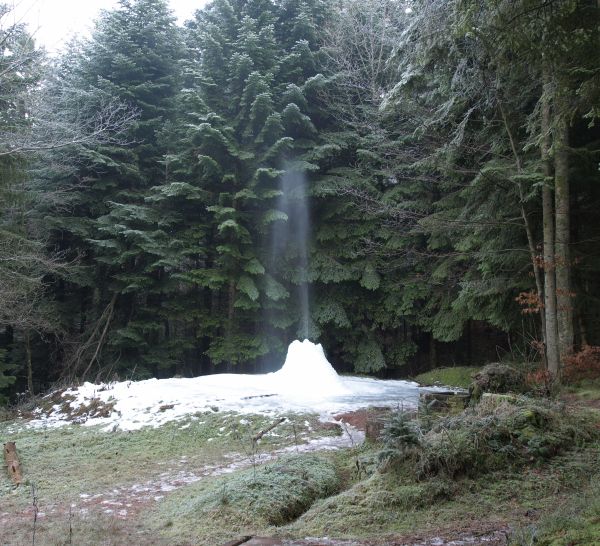 I don’t think we need to include any photos of the snow here, as the UK has seen its fill this year. Though it has been very pretty all month looking out of the window, and also walking. During one of the thaws we came across a unusual sight on the edge of the forest. The field was green once more, but at the edge was a circle of white, icy snow with a jet of water rising out of a white cone formed by spray from the fountain freezing as it fell.
I don’t think we need to include any photos of the snow here, as the UK has seen its fill this year. Though it has been very pretty all month looking out of the window, and also walking. During one of the thaws we came across a unusual sight on the edge of the forest. The field was green once more, but at the edge was a circle of white, icy snow with a jet of water rising out of a white cone formed by spray from the fountain freezing as it fell.
Usually January is a time for sorting out garden seeds, though somehow the snow hasn’t stimulated green thoughts. The seeds which have been most difficult to get hold of here have been parsnip (closely followed by Brussels sprouts). In the earlier years we always had to get them from England, but had been finding them here occasionally in the last couple of years. And now its official. The Times (so it must be true) reports that in France, having spurned parsnips as fit only for animals and the British, apart from during the war years, “the humble parsnip is being hailed a symbol of culinary refinement and political correctness, with renowned chefs and well-heeled Parisians paying up to £3.50/kg for a taste.” The article also mentions the return of the Jerusalem artichoke, so our garden is doing well, on two counts, though we won’t be planting the other légume oublié, the swede (too many unpleasant school dinner associations).
So on this auspicious day of Chandleur, even though we haven’t got a gold Napoleon in one hand and a frying pan with pancake mix in the other, here’s to good crops (especially parsnips) and sufficient riches in the coming year!
Panoramas of Bennwihr church (Alsace) and of Saint-Dié cathedral, Tour de la Liberté, and le Corbusier factory
Click on the photographs or the links below to go to the page containing the 360˚ panoramas
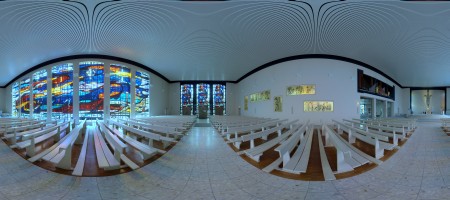
Bennwihr (Alsace): l’église Saint-Pierre-et-Saint-Paul
.
.
Saint-Dié: Interior and exterior of Cathédrale Notre-Dame de Saint-Dié
.
.
Saint-Dié: La Tour de la Liberté
.
.
.
Saint-Dié: The only factory designed and built to plans by Le Corbusier
Pergola, patchwork and pink pants: Everyday life in Entre-deux-Eaux, Year 8, Weeks 15 – 28
To download a printable Adobe Acrobat version click on this link E2EYear8Weeks15-28.pdf (three A4 pages)
It’s a sad fact that it is usually when we’re thinking of travelling to England, that I realise that we haven’t communicated for a while, usually because not much seems to have happened in our rural tranquillity. So amid the present chaos, here is a quick update on E2E happenings. I say chaos, because the chain of purchasers for my mother’s old flat is getting restless at delays (with solicitors and Housing Association and threatening to withdraw). So we are packing to leave on Friday to clear the flat in hope the sale is completed. At the same time, having long planned our first family Christmas here, and eight return tickets with Ryanair or BA having long been booked, Ryanair have just withdrawn their Stansted-Basel service from early December and BA are threatening to strike over Christmas. Hence chaos.
Meanwhile, you could probably write the annual autumnal newsletter – with resumption of the hunting season and international patchwork festival in September; sunshine, brilliant leaf colours and the international geography festival in October; visiting local ghouls ringing the doorbell at Halloween; then rain and mist in November! And so it has been this year. However, a few novelties have been the pink trousers, a convent’s sale-of-contents and an abbey’s plant sale. We’ve also had a few projects of our own on the go, including pergola, patchwork and plumbing.
The three quarter-length tight fitting bright pink trousers belong to our neighbour Mme Laine, together with some pink peek-a-boo shoes. I have for so long been accustomed to her more traditional outfits of Crimplene dress for best (with tightly permed hair) and flowered overall or brown stretch trousers for every day, that the new image stunned me, as we set out together for the E2E oldies’ September afternoon of gossip, cards and cakes. Has the trip for two to Venice that she won last autumn in the oldies’ lotto changed her horizons? She and her sister have also booked to go on all the oldies’ organised coach trips. And there was also an ascent by balloon planned for fourteen family and friends. M. Laine, it should be added, was wisely staying out of all this, and just sticking to his occasional hunting pursuits. Sadly the balloon trip was cancelled, but the traditional village is changing!
Previous newsletters have mentioned the number of new houses being built in the village. Now that they have been there for a year or two the young couples are turning their attention to their gardens. This seems to involve a lot of lorries and earth shifting and boulder planting. At school we only learnt one French word for garden, which was jardin. However my local source of all local information, Mme Laine, insists that number 12 (we are 13) are not making a jardin but a cour. A yard? What would it have in it, I asked, anxious to improve my vocabulary. Oh trees, flowers and grass she replied. To her practical mind, I therefore presume, a jardin must consist of edible plants in neat rows. And, as she sighed, young people don’t have jardins any more, they just buy everything. And, talking of vocabulary, Scrabble has resumed, with its quota of unfamiliar words, – often unfamiliar to all the group. My great coup was to make the very plausible-looking word geophile. When questioned as to what it meant, I airily said it was a lover of earth. As it turned out to be the correct highest-scoring word, its meaning was checked, amid disbelief. It’s, apparently, another word for mille-pattes or millipede! So we can’t call our neighbours at number 12 geophiles, as the lorries shift endless piles of earth around (not to mention all over the road).
It’s always good to do something a bit out of the ordinary with visitors, especially when those who come regularly have seen most of the tourist sights on previous visits. 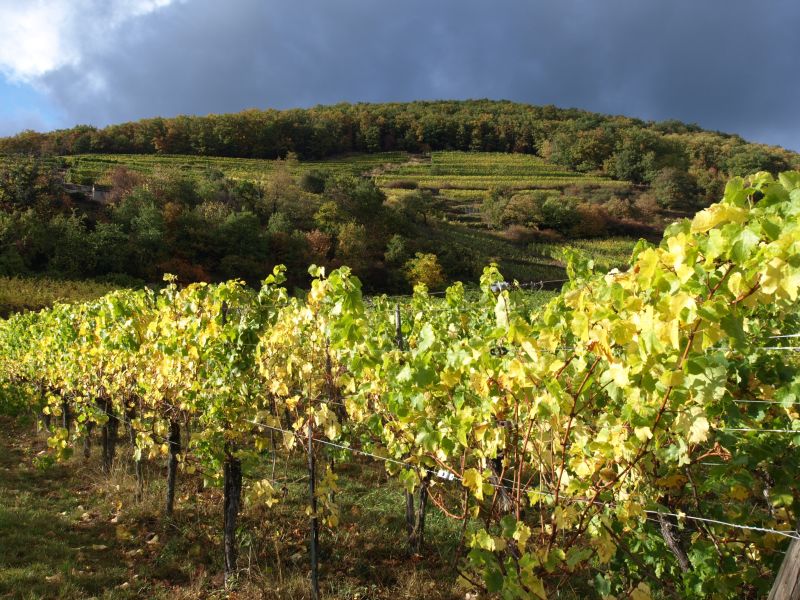 So while Ann and David (Hart) were here, we one day followed a very hearty lunch at the auberge St Alexis with a walk through the vineyards below,and then we queued to be let into the sale at the convent of the Clarisses at Sigolsheim. We’d previously learnt (whilst tasting and selecting wine at the Sigolsheim co-operative) that the convent was to close and the remaining four or five sisters dispersed, some to nursing homes. And now all their goods were to be sold to fund-raise for the order in Africa and for the upkeep of the elderly nuns. The village had provided enthusiastic volunteers and also contributed many more items to the sale. So we walked through the convent, examining books in one room, sewing things in another, crockery and cutlery in the kitchen areas, gardening and wash-day implements in another, with simple tables, cupboards and shelves lining the corridors. It was quite sad to see their few possessions, and also the esteem in which the sisters were held in the village. Ann and I bought some sewing items and John picked out a pretty jug.
So while Ann and David (Hart) were here, we one day followed a very hearty lunch at the auberge St Alexis with a walk through the vineyards below,and then we queued to be let into the sale at the convent of the Clarisses at Sigolsheim. We’d previously learnt (whilst tasting and selecting wine at the Sigolsheim co-operative) that the convent was to close and the remaining four or five sisters dispersed, some to nursing homes. And now all their goods were to be sold to fund-raise for the order in Africa and for the upkeep of the elderly nuns. The village had provided enthusiastic volunteers and also contributed many more items to the sale. So we walked through the convent, examining books in one room, sewing things in another, crockery and cutlery in the kitchen areas, gardening and wash-day implements in another, with simple tables, cupboards and shelves lining the corridors. It was quite sad to see their few possessions, and also the esteem in which the sisters were held in the village. Ann and I bought some sewing items and John picked out a pretty jug.
I’m glad that no visitors came over specially for the patchwork festival in Sainte-Marie-aux-Mines this year, as the quilts were not as interesting or innovative as in previous years (I may have said that last year too). However their fashion show was certainly “interesting”, especially if you’d been longing to wear a busby of made from pink and purple rasta locks, with a skirt made of jagged bits of tartan, black striped tights and platform boots, an outfit unfairly, I thought, billed as style anglais. I, like the rest of the audience, much preferred the flower power sevillan with its flouncing flamenco dresses with flowers. However, uninfluenced by trends, I have been greatly enjoying making my own patchwork throw for Leila’s new sofa. It’s been fun digging out old dress and shirt materials and making random patterns of all the colours. Some of the garments did indeed date back to flower-power days – I’d forgotten quite how short some of them were (not to mention how much slimmer we both were then). And fortunately John’s sister has given him a new dressing gown to replace the one cut up for the patchwork!
And while I’ve been engrossed in patchwork, John has been changing the plumbing. This was necessitated by the sewerage survey earlier this year. John has re-routed the cellar waste pipes of the old house to flow into the more modern (and compliant) septic tank and filter bed built for the new part. To do that, the WC pan in the barn also needed to be changed from vertical (directly into the old tank) to horizontal exit to join with the new pipes. Once we get the septic tanks emptied we should be completely legal! John has also added guttering to the re-roofed (thanks to Alistair’s hard work) workshop. But I have to admit that I was much more excited by the pergola John made while I was swanning off with the train-gang in Broadstairs. It was a lovely surprise.
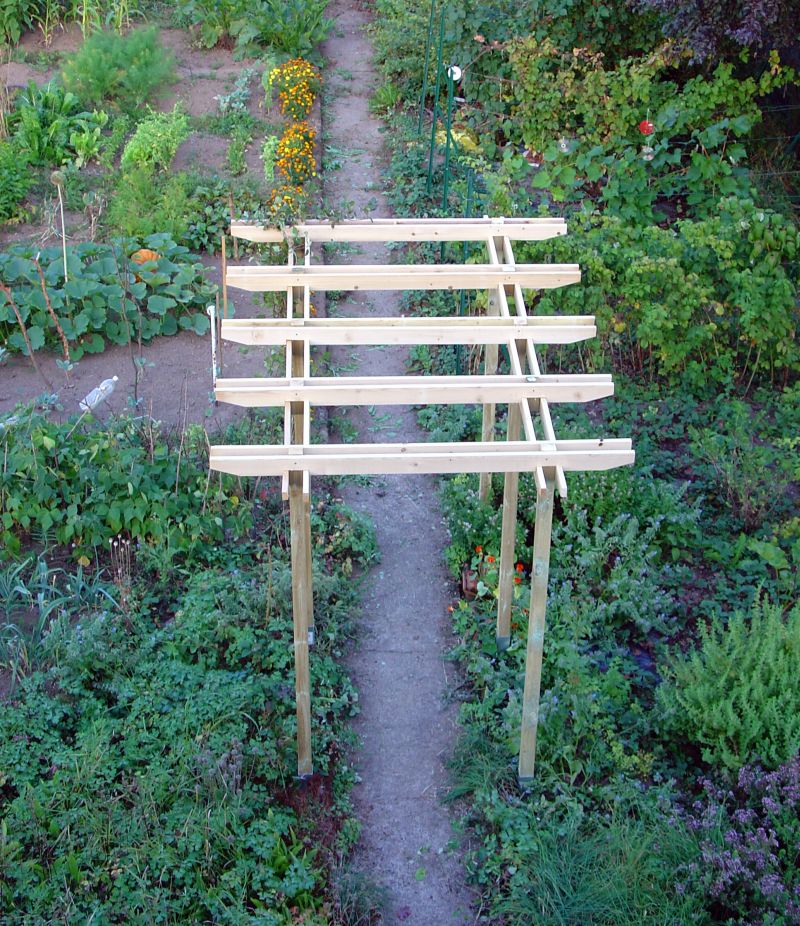 So far we only have one rose and one honeysuckle growing up the new pergola, in what is definitely our jardin, as it is at the entrance to the vegetable patch. So when we saw that there was a sale of roses, shrubs and trees at an abbey we had never visited, we drove off towards Epinal to it. Our friend Nicola, who was a volunteer at the Chicago Botanical Garden, used to talk with enthusiasm about the garden. Whilst Roger, a structural engineer, subsequently said that the abbey church looks too structurally unsound for him to go inside. We did go into the church, and I particularly liked the recently painted icons. There were also large flower paintings. Later that day, undaunted by structural concerns, there was to be a concert and the candles were being lit. It seemed to be a very creative community. A single brother, Brother Symeon, had been responsible for developing the four hectares of grounds (which were definitely billed as jardins) over the 27 years that the Community of the Beatitudes has been there. There was a white garden with statuary, a hydrangea garden in front of a gîte that they let, a lake with paths shaded by trees and tall grasses, a heather garden and everywhere exotic trees like an Indian chestnut with small oval conkers.
So far we only have one rose and one honeysuckle growing up the new pergola, in what is definitely our jardin, as it is at the entrance to the vegetable patch. So when we saw that there was a sale of roses, shrubs and trees at an abbey we had never visited, we drove off towards Epinal to it. Our friend Nicola, who was a volunteer at the Chicago Botanical Garden, used to talk with enthusiasm about the garden. Whilst Roger, a structural engineer, subsequently said that the abbey church looks too structurally unsound for him to go inside. We did go into the church, and I particularly liked the recently painted icons. There were also large flower paintings. Later that day, undaunted by structural concerns, there was to be a concert and the candles were being lit. It seemed to be a very creative community. A single brother, Brother Symeon, had been responsible for developing the four hectares of grounds (which were definitely billed as jardins) over the 27 years that the Community of the Beatitudes has been there. There was a white garden with statuary, a hydrangea garden in front of a gîte that they let, a lake with paths shaded by trees and tall grasses, a heather garden and everywhere exotic trees like an Indian chestnut with small oval conkers.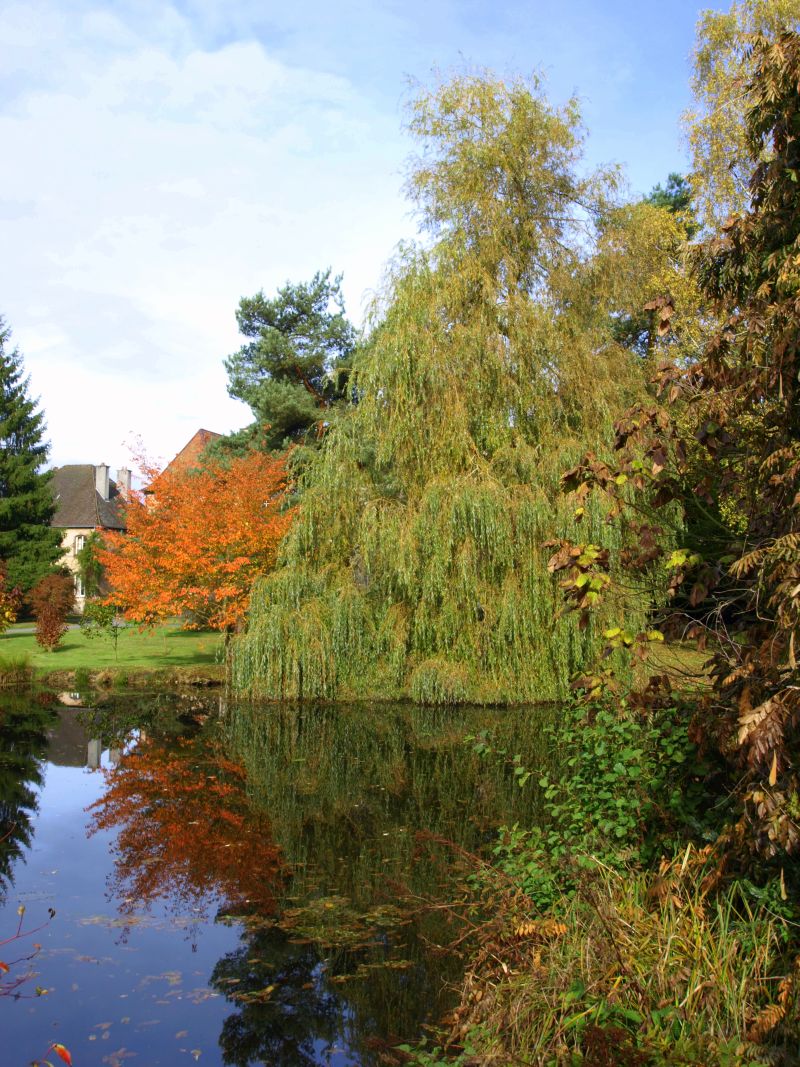 It was a very peaceful garden – ideal for contemplative strolling. We didn’t buy a rose for the pergola, but perhaps we’ll return in spring for their bedding plant sale. On the way back, John “collected” a few red oak saplings from the roadside, reasoning that the efficient verge-cutters would dispose of them if we didn’t. So maybe one day our meadow will be as magnificent as brother Symeon’s jardin.
It was a very peaceful garden – ideal for contemplative strolling. We didn’t buy a rose for the pergola, but perhaps we’ll return in spring for their bedding plant sale. On the way back, John “collected” a few red oak saplings from the roadside, reasoning that the efficient verge-cutters would dispose of them if we didn’t. So maybe one day our meadow will be as magnificent as brother Symeon’s jardin.
With the Harts we also went to the new wine festival at Eguisheim. The village square, presided over by the statue of Pope Leo IX (who was born there) was filled with tables, stalls and a stage with a chanteuse and her accompanist. It was all very jolly. We sampled some of the potent new brew (in plastic beakers), Ann bought some freshly baked kugelhof, and we sat and watched the elderly dancers re-living their youth in a perhaps more stately version. Our own grapes at the end of the vegetable patch had fruited well this year and John made two large batches of grape jam, the second batch spiced a bit like mulled wine. Mm! It has joined the earlier plum jam and plum chutney (the “ornamental” plums were gathered from tall trees while Ann and Derek were here, using John’s invented device made from a wire coat hanger, tights and a long pole). The walnut trees have produced a good harvest too, as the mice (who move into the barns with the bad weather) will attest. Piles of empty shells have been found. Drying and hanging facilities since have been changed (for walnuts, not mice).
So will all ten of us be sitting round at Christmas cracking walnuts and spreading spiced grape jam? It’s just as well that, having investigated local suppliers, we haven’t yet put our name down for a Christmas turkey or capon. Will anyone make it here next month? Watch this space.
Just in case you think something looks different…
…… it has changed!!
One of the advantages of using WordPress is it is possible to change the presentation style without any (or, more realistically, very little) change to the content.
I’ve spent some time looking through some of the hundreds(?) of available styles and opted for this new plain style which seems both to have greater clarity and has been easier to modify slightly to meet my specific requirements. The only problem I’ve noticed is some of the images inserted in the older news items are not aligned to the left margin and/or don’t have text wrapped round – but that occurred with other styles I tested so it is probably something I did wrong in the first place! I don’t think that will cause anyone real problems and, if we have a cold winter, I may just have time to spend a few hours tidying them up 😉
Restaurants comments and photographs update
There haven’t been any restaurant comments added here for some time even though we’ve been eating out! We have been going back to old favourites quite often and it didn’t seem worth adding them….and then, even when we visited new restaurants, we got out of the habit of commenting.
However, there have been significant changes at our favourite restaurant of several years, the Blanche Neige. All the serving staff we knew well, from our frequent visits, left during 2008. Thomas the manager was the last to go and by lucky accident we were there during his last week in December. Then I discovered last weekend the chef had also moved on in July 2009. We’d been at the Blanche Neige in August and noted some changes – mainly reduced menu options, increased prices, and the saltiness but there was no visible indication of any change in the kitchen!
The original chef, Mike Germershausen, and his wife have now opened their own restaurant in Marckolsheim and we visited a couple of days ago. He seems to be building up a regular trade already which is not surprising as the prices are more reasonable and the restaurant is more accessible from Colmar and Selestat. The food and presentation are much the same, but slightly simpler. He said he found it a bit odd at first as the restaurant mainly served pizzas under the previous owner. When it re-opened the pizza eaters came expecting their usual food, were surprised by the menu and left again. Auberge de la Ferme Hueb, Marckolsheim
All our restaurant photographs https://www.blackmores-online.info/Restaurants/
New autumn panoramas added
Some 360 degree panoramas
– a walk in the woods near the col d’Anozel
– from our fields showing the farmhouse and also
– from within the orchard as autumn arrives and leaves fall
added on the Panoramas page.
Assumption, roof tiles and quarantine: Everyday life in Entre-deux-Eaux, Year 8, Weeks 4 – 14
To download a printable Adobe Acrobat version click on this link E2EYear8Weeks4-14.pdf (three A4 pages)
As we sat on the balcony on Saturday morning with our coffee and croissants, the church bells rang out over the fields. Breakfast-time seemed a bit early for a wedding or a funeral. As there were a couple of flea markets, we showered and drove off to them, without reflecting further on the bells.
We went first to Corcieux, the pleasant town where we’d been camping when we first saw the farmhouse, 19 years ago. This time we parked opposite the café, near the church. People were pouring out of the church. A popular event. Then it dawned that the bells and service, like the flea markets, were in honour of the Feast of the Assumption. So everything apart from cafés and restaurants was closed, while just down the road by the mairie, an equally large crowd (more dogs here though) were milling round the flea market stalls.
On the first stall my eye was caught by some big plastic bags of freshly uprooted grape hyacinths. A mere euro for all those tiny bulbs? They looked healthy too, and must like the climate to have been producing such a generous surplus. Our new garden path, which Alistair laid (see below), will look lovely in spring with a border of vivid blue flowers.
The second market was in a small town on the river Vologne. It was a good one, though we left empty handed. We’d parked outside the cemetery, which had a notice about commonwealth war graves. And there under a union jack and a tricoleur, were a row of graves for the entire crew of a plane shot down by a German fighter in April 1944. Perhaps there should have also been a Canadian and an Australian flag for two of the crew members. So many sad histories all around here.
On our way back we had a look at the old camp-site we’d stayed at the year we bought the farmhouse. We thought we must have taken a wrong turning as it seemed so far out of Corcieux. Did we really make the children walk all that way every day during that very hot summer? Finally we saw a wall with Camping still painted on it, and people sitting round the swimming pool. But it was no longer a camp-site, just an ordinary house (with handy a football pitch still in the next field). On the other side of Corcieux one of the other camp-sites now seems to be covered with wooden chalets, which are encroaching on more and more fields. It must have smothered any smaller competition!
Another bit of nostalgic retrospection last week was a trip with Roger and Dorinda to the Blanche Neige restaurant. We hadn’t been back since December, as all the friendly waiters were leaving or had already left. The food was as good as ever, as the chef is still there but their standard three-course menu has unfortunately vanished. The new waiters were equally friendly, asking “Is this your first visit?” We reckoned that between us it must be our 21st visit, not to mention John’s splendid 60th birthday feast. Another shock was that the coffee machine had changed and they no longer make their tall glasses of layered cappuccino. I wonder what they’ll make of our comments form mentioning cheaper menus, cappuccino, and less salt please.
Fortunately, nothing changes at the St Alexis in the woods, not even the menu. We went there again when Ann and Derek were with us, and sat out on the terrace above the vegetable garden. Our waitress was a bit grumpy until the end of her shift when she perked up and told us how much she likes the hours and the drive there. One day she’d seen fifteen deer and another day a wild boar with two babies on her way. The previous time we’d been there with Ann and Derek we’d intended to do some wine tasting afterwards, but felt too replete to bother. So this time we stopped in one of the wine villages, Sigolsheim, before lunch. The co-operative there is very friendly and we all like their wines, so bought some more. While there, I was a bit confused by a note on the counter about the departure in August of the Clarisses. For the asparagus fields belong to a certain Clarisse. But it turned out to refer to the Clarisse nuns whose convent was being disbanded and the nuns dispersed. John read last week about the farewell meal the mayor and village had hosted for the nuns. What at lovely idea! I wonder if the Sigolsheim wine flowed freely or whether it was more sedate. The mayor seemed really sorry to be loosing the benign influence of the convent prayers.
We were lucky during Ann and Derek’s visit as rain had been forecast for the whole week. But it was fine when we picked them up at Basel airport, so we decided to return along the scenic Route des Crêtes. We stopped at a café on the way, and found the wind rather cold and the distant Alps no longer visible. And the skies got darker as we approached the Hohneck. I was keen to stop and look at a monument to the 4th Tunisian Tirailleurs, who’d fought a heroic but loosing battle up there in the thick snows of December 1944. No snow for us in July, but suddenly the skies opened and the rain sheeted down on this exposed mountainside. I was the only one who was foolish enough to get out of the car for a closer look. However, after that the weather improved, and the day we decided to climb to the top of the Donon and its fake Roman temple, it was really hot (and we didn’t even get to the top as lunch at the Belle Vue called).
Our previous visitors had been Sue and Alistair. Alistair had arranged to come out early to work alongside John on a new roof for the workshop. However, with John’s Achilles tendons continuing to be a problem, it was a case of Alistair doing all the roofing, with John offering “advice” from the foot of the ladder. But not only did the roof get done (and the golden weather cock settled back on the ridge), but also a new drainage channel, garden path and compost heaps were constructed and dead and diseased trees uprooted and burnt. And all in very hot weather. We must have had at least three large bonfires of debris. But none of them were as spectacular as the Feux de la Saint Jean in Saulcy that weekend. At 10pm the small fair was lively, with dodgems, trampoline and roundabout outside the mairie, whilst on the football pitch the Saulcy Dauphines were just finishing a twirling routine with illuminated batons. This year’s huge log fire had been constructed in the shape of a well, and the firemen climbed up and set fire to the bucket. The fire spread dramatically up the “chain” and along the beam until the whole structure was on fire, lighting up the sky. And all around a magnificent selection of fireworks were whooshing up, exploding and cascading down. Magic!
After all the hard labour, we drove back to Nottingham with Sue and Alistair. Mme Laine usually takes all our post from the postman while we’re away, and we usually catch up with the gossip when we collect it on our return. But this time, after spying our car pass, she phoned to say that she had just been down and hung a bag on our door knocker, as she’d heard all about the swine flu in England and didn’t want to risk seeing us. Anyone would think there weren’t any cases in France. I think we’re considered out of quarantine now. But unfortunately I set off again on Friday (for the annual train-gang reunion) so may get quarantined again.
Blanche Neige web page
Saint Alexis web page
la Belle Vue web page
la Belle Vue menu page
Saint-Dié: The only factory designed and built to plans by Le Corbusier
In November 1944 the whole of the centre of Saint-Dié was dynamited and burnt to the ground by the retreating German troops; over 2000 buildings were destroyed. Any remaining walls and shells of building were demolished by the council. In 1945 Le Corbusier was appointed architect to redevelop both public and private buildings of the town. He put forward a radical plan which involved separation of roads and pedestrian areas; much of the accommodation for residents was to be in tower blocks (Machines à habiter). But the project was too revolutionary for both the town council and population (who would have had to give up their rights to the land they owned and individual properties) and was rejected in early 1946 in favour of a more traditional plan based on the old town centre layout. Le plan de reconstruction de Saint-Dié (1945)
Eventually the only industrial building ever completed by Le Corbusier, the Usine de Bonneterie Claude et Duval, was built in Saint-Dié during 1948-51. In July 2009 the factory was included in the UNESCO World Heritage list. Today it is still in use as a factory but the building is decaying probably due to poor post-war building materials and lack of maintenance.
If you click on Le Corbusier: Usine de Bonneterie Claude et Duval, Saint-Dié for the panorama
………………………………………………
Saint-Dié: La Tour de la Liberté
La Tour de la Liberté was constructed in Golbey, Vosges and erected in the jardin des Tuileries, Paris in 1989 as part of the celebrations for the bicentenary of the French Revolution.
In 1990 Saint-Dié purchased the tower for a nominal one franc and it was re-erected the centre of the town in parc Mansuy.
Click on this link La Tour de la Liberté, Saint-Dié
………………………………………………

